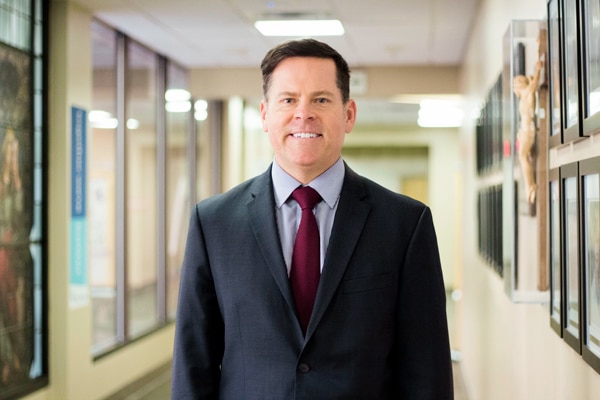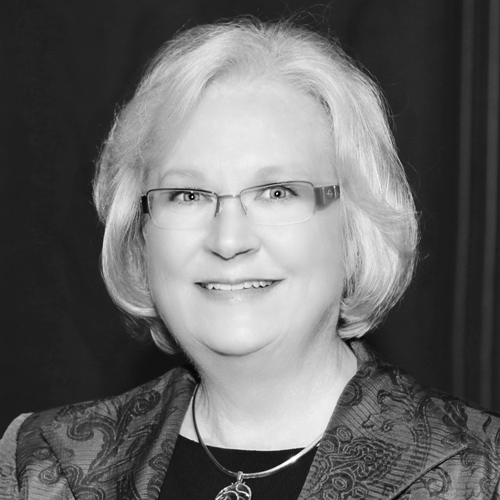To some it might be a surprise, but more neuroscientists than ever before from around the world are heading to Little Rock, Arkansas, to learn. It’s also where they’ll find Chris Stines, who is guiding a medical renaissance that promises to transform Catholic Health Initiatives (CHI) St. Vincent into a national and international hub for neurosurgical research and care.
The 130-year-old regional health network has topped best hospital lists by US News & World Report and Becker’s Hospital Review year after year. Yet Stines, vice president of operations at CHI St. Vincent North hospital, is ushering CHI St. Vincent into the next phase of its evolution through the development of facilities and talent on a global scale.
Stines works with a team of five neurosurgeons—all first-generation Americans—from Lebanon, Pakistan, Iran, and Greece whom comprise the Arkansas Neuroscience Institute (ANI). They perform more than one thousand surgeries every year on some of the most complex patient cases.

The team is led by world-class neurosurgeon Ali Krisht, who ranks in the top 1 percent of all neurosurgeons in the United States by the physician ratings firm Castle
Connolly. Dr. Krisht is also the chief editor of Contemporary Neurosurgery Journal. His groundbreaking treatments of rare tumors, venous malformations, and aneurysms have achieved survival rates that are three times the national average. In fact, ANI patients’ three-year survival rates for glioblastomas, a type of brain cancer, is 34 percent compared to the national average of roughly 8 percent.
“We had a patient who came to ANI after seven surgeries elsewhere,” Stines recalls. “Previous surgeries couldn’t get all of the brain tumor, and she had lost eyesight in one of her eyes. Dr. Krisht was able to get the whole tumor out the first time, and the patient asked Dr. Krisht, ‘Why didn’t I know about you sooner?’”
To expand the reach of the Arkansas epicenter, Stines is spearheading a $13 million renovation of the sixty-nine-bed North Little Rock hospital to create a one-stop neuroscience destination. Set to be complete this fall, the facility will feature ten additional new ICU rooms, four updated operating rooms, a 3T MRI, 128-slice CT, and a biplane angio suite, as well as a new pharmacy, helipad, and presurgical testing area.
Adjacent to the hospital, CHI St. Vincent is also developing a cutting edge research and education center to expand relationships with new generations of neurosurgeons. Currently, ANI facilitates educational training with Taiwan, Japan, Russia, Brazil, Belgium, Finland, Mexico, Holland, Sweden, Nigeria, and Italy. The site is expected to be complete this fall and will house clinical and research space, as well as a 150-seat auditorium.
It’s also Stines’s collaborative approach that is not going unnoticed by his peers. “In working with Chris to establish intraoperative neruomonitoring for spinal procedures at CHI, AMS has found a partner who is able to keep patient care at the forefront while delivering against mutual business goals,” says Brad Vinson, CEO of Advanced Monitoring Services Inc. “He is a great collaborator with the ability to view the big picture and yet not let any details fall through the cracks.”
To further understand Stines’s ability and dedication to propel CHI St. Vincent’s neuroscience institute to the world stage, look no further than his own career path.
At age eight, Stines already had a business mind-set. The son of a dentist and a Mary Kay saleswoman, he sold cologne in class, candy bars from his locker, and repackaged golf balls he found around the golf course in egg cartons. “But my dad was the first to teach me about serving the poor and vulnerable,” Stines says. “He had a sliding pay scale for his patients. My mother taught me the importance of working for a company that shares
your values.”
Stines attended Indiana University (IU) to earn a bachelor’s degree in economics with a certificate in business and a master’s degree in healthcare administration. He stuck around the first year after graduation to work in the IU School of Medicine’s obstetrics and gynecology department. He was promoted the following year in 1995 to executive director of a large IU-affiliated neurosurgery physician group practice, where he spent the next twelve years working with department head Dr. Paul Nelson.
“Dr. Nelson taught me many things, but two things he always said were: ‘Always take the high road, and there’s a big difference between zero and one.’ That means there’s a big difference between nothing and something,” says Stines, who considers Dr. Nelson a mentor, friend, and father figure.
As a result, Stines made the first step toward hospital administration with Purdue University’s acute care veterinary hospital in 2007. From there, he rejoined Dr. Nelson at IU to negotiate a significant merger as the executive director of neurosurgery and president of the research-based nonprofit Foundation of Goodman Campbell Brain and Spine.
During this time, however, divorce upended his personal life. Stines describes the shock of coming home to an empty house as the catalyst prompting a figurative journey in his career—one that literally took him around the world, starting in Africa.
Stines joined a church mission trip to Kenya, where IU also happened to have a partnership with Moi
University. He shadowed administrators at the Academic Model Providing Access to Healthcare (AMPATH), which was created to help stop the spread of HIV/AIDS. There, he met with Dr. Florentius Koech, the only neurosurgeon in the region, and learned about the area’s high incidence of neurological trauma from motor vehicle accidents. Their conversation led to the creation of an IU rotation of neurosurgeons in Kenya to provide additional care and a visiting lectureship for Dr. Koech at IUSOM Indianapolis.
“I toured the wards of the hospital in Eldoret, where there were often two grown men to a bed,” Stines recalls. “Clearly, not an ideal, sterile environment for patients, but that’s all they had. Africa was a juxtaposition. It had incredible beauty with blooming trees and flowers. But there was also an incredible ugliness from the lack of resources and poverty.”
Stines also visited Kibera, Kenya, where a million people live in one square mile. With not much running water and other dire living conditions, it’s one of the largest slums in the world. He describes residents as kind and caring people who are struggling to get by.
The following year, Stines went to South America. He traveled up the Amazon River on a medical expedition to help locals in need. They distributed eyeglasses, doctors and nurses delivered medicines, and dentists performed extractions. Stines took photographs of the families in each village they visited and presented them framed copies. “I was like the ambassador of goodwill for the team,” he says. “Even though I’m not a physician or nurse, there are other nonclinical ways to contribute.”
His travels strengthened his resolve to pursue international medicine administration, and a role in the Persian Gulf caught his attention. His year in Kuwait kicked off in 2012, during which Stines represented Johns Hopkins Medicine to implement the university’s best practices overseas as its chief operations officer and project director. Through the partnership with the Kuwait Ministry of Health, his team boosted standards of care and facilitated doctors’ on-site learning exchanges between Kuwaiti hospitals and the Baltimore-based university. After work hours, his commitment to the poor and vulnerable was lived out through volunteering to procure and distribute food staples to poor immigrant workers of Kuwait.
An opportunity to return stateside in 2013 did not disrupt his focus on international medicine. He joined CHI St. Vincent as its executive director of neurosciences in Little Rock. The city offered the hot climate that Stines was accustomed to while CHI provided an opportunity to continue his commitment to serving the poor and vulnerable. Service to the poor and vulnerable is one of the nine metrics that are measured and communicated monthly at CHI.
His purview expanded shortly thereafter as the division’s market director in 2015 and again with his promotion to vice president of operations in 2016. All in all, Stines describes his nontraditional path to CHI St. Vincent as providential.
“Neuroscience has always intrigued me. The human brain is like the last frontier,” he says. “My work to support great minds and hearts and improving health outcomes is what drives me. And our mission at CHI, supported by education and research and grounded in the Gospel, urges us to emphasize human dignity and social justice as we create healthier communities everywhere. It’s exciting work, and it’s the why that is unique to CHI.”
Photo: Gareth Patterson

